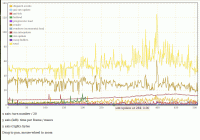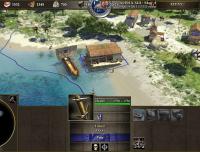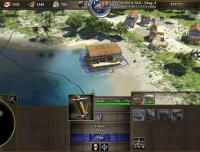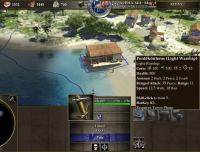Leaderboard
Popular Content
Showing content with the highest reputation on 2013-04-30 in all areas
-
The "church had no tolerance of science" thing is an old stereotypical view of the Middle Ages that no one really subscribes to today. http://bede.org.uk/university.htm2 points
-
Maybe we should just skip the fixed point vs float discussion for a moment. 20% sounds like a lot, but I think you measured that at the beginning of the game and the bigger problem is later when the simulation starts using up most of the resources. Also it could make such a significant difference simply because other parts of the engine aren't optimized yet and have to do too many calculations. Philip indicated something like that related to the short-range pathfinder. Last but not least there seem to be different opinions that are well argued but still no real consensus. If you will eventually become a fulltime programmer you should start with a less contentious issue . Don't get me worng, but no matter if your right or wrong in that matter it would be good to add something everybody is happy with. There are enough tasks for that, it shouldn't be the problem. In my opinion the main problems currently are: 1. Pathfinder: Meaning the pathfinder itself that is used for unit movement but also the pathing functionality that the AI need and currently implements separately because there's no interface to the engine's pathfinder implementation that fulfills the requirements. 2. Multithreading support: Separating AI and Simulation from the rendering would about double the average framerate and would get rid of lag-spikes happening when for example the AI calculates the map for dropsite placement (multiple seconds on large maps!). I've tried doing that for the AI but my conclusion was that the spidermonkey upgrade needs to be done first (3). 3. JavaScript Engine improvements and Spidermonkey upgrade: I'm currently working on that in ticket #1886. It's difficult to predict how much that will improve performance. For Firefox the Spidermonkey performance improved a lot but our situation is a bit different. Anyway, the upgrade is need for various reasons - one being the multithreading support. An issue we have with all kinds of performance improvements is how to measure them. You are talking about 20% improvement which is inherently quite a random number you measure in one specific situation on a very specific plattform (Hardware, driver, OS, compiler options) and with unspecified settings. It would be very helpful both for making good judgements and for motivation to have better ways of measuring performance. What's missing is some kind of benchmark mode that tests different aspects of performance in scripted ingame scenes. It could be some camera movements over dense forests, over water, a lot of units fighting, an army moving through a forest and pathing through a narrow gap in formation, a maximum of 8 AI players doing their normal AI-calculations etc. It should store all the profiler information in the background to draw nice graphs later like how the ms/frame performance changed over time and what parts of the engine used most of the calculation time in these different situations. We already have most of what we need for that. I think that would be a very good task for you to start with, if you like. The pathfinder would be the most important task to continue but that's probably a bit though to start with. We already have two integrated profilers in the engine (simply called Profiler1 and Profiler2). Profiler1: "source/tools/replayprofile/*" contains a Perl script to extract profiling data from the text files generated by Profiler1. There's also a HTML file that can display nice graphs like that: Issues with profiler1: There's a bug that messes up the profiling data after some time. I havent analized it any further but you should get what I mean if you let it run with a game for a few minutes. It has some issues with multithreading In some situations it created huge files of profile data. I once got a 32 GB file and it has such an impact on performance that the data looses its significance Profiler2: Philip create this one which is very helpful for measuring accurately what happens in a single frame. Check the forum thread for more information. It even supports displaying multiple threads and calculations on the GPU. Profiler2 keeps the data in fixed size memory buffer and overwrites the oldest data when the buffer is full. The format is a binary format with much less overhead than profiler1's output. It makes the data accessible via web-server. Maybe it would be better to extend this profiler to save the data in the memory buffer to the disk. What do you think?1 point
-
Yup, each civ has a fortress in City Phase. That sounds like a good idea. Maybe a "0 A.D. for Age of Empires fans" page or something. Possibly on the website rather than in the game, although I could definitely see it as part of the in-game manual.1 point
-
In this current case, I'm running a 4 year old laptop with a cheaper Intel i7 mobile chip. I'm not getting that much performance out of the game and changing to floats gave at least 20% performance increase in a regular game. With the 'big combat demo' it might give even more benefit. The main target platforms all have an integrated FPU on the chip and it's not reasonable to suffer a performance drop because rare embedded systems without an FPU are considered as a possible release target. It just makes no sense - even ARM processors (probably on your phone too) have an FPU. Floats are fast due to hardware support; sure - not all float values can be precisely represented, but that is something that can be accounted for.1 point
-
Smart people who think of efficient algorithms. Most of the bottleneck right now is pathfinding. The current pathfinder is a fairly naive A* pathfinder, and is pretty slow. A lot of games either use A* with a quadtree (SC:BW I think, and AoM and some others) or HPA*. The new pathfinder will use JPS, a newer approach that is at least as fast and has some other nice properties. Commercial games also do some clever tricks to make the pathfinder faster. Some of those might already be implemented in 0 A.D. actually, it's just that the short-range pathfinder is too slow for them to be particularly noticeable. I'm not sure how things like the range manager are handled in commercial games - given that they are proprietary as opposed to open source that would be very difficult to figure out. Most big games also use highly optimized renderers, although ours is reasonably fast right now it would be nice to move to a tried-and-true renderer like Ogre3D, but that would be extremely difficult.1 point
-
Yes, Flattr has been setup since 2011-10-20, it just hasn't been advertised much. Over the last 18 months it's been running, we've got €189.05 ($246.73 USD) from people Flattr'ing us.1 point
-
1 point
-
1 point
-
Yes, I think that would help, as would adding a few 5000 stone/metal mines periodically, instead of just 1000 ones. Ensuring that there's a high point with lots of wood near every player would be nice. Scattered other high points could serve as places to fight for expansions. It would be very nice if every/almost every map had similar fish/berry numbers to Belgian Uplands and Deep Forest, especially if regenerative berries were implemented (speaking of which, that could work for fish too). I think that would really help with the current food source problems. If that and infinite farms with diminishing returns make it into Alpha 14, it would be a good gameplay enhancement.1 point
-
an AOM design for initial attacks would be good and easy to use in "battle for middle earth 1" there was a button to switch between weapon(could be placed in the formation/stance UI) : i think it's the most efficient way to deal with units having more than a single weapon, you can easily swich depending of what you need in the battle1 point
-
Whoa, take it easy, Morganiccc. He's just showing his opinion. And warcraft 3 didn't have walls and/or other heavy defenses like 0 A.D., so your argument is invalid. In both Warcraft and Starcraft the environment and choke points are the key to defend your base. In 0 A.D. the environment is just a factor, the key to be a successful defender lies more in knowing what/where to build and of which units your army is made of.1 point









